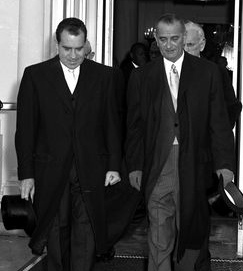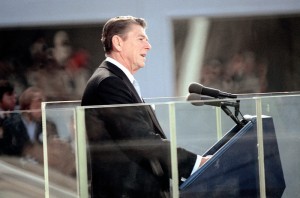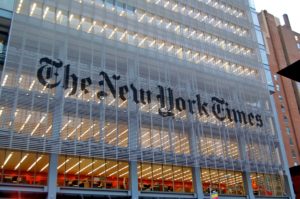How the NYT Plays with History
Special Report: By failing to tell the hard truth about Establishment wrongdoing, The New York Times — along with other mainstream U.S. media outlets — has destabilized American democracy, reports Robert Parry.
Whenever The New York Times or some other mainstream news outlet holds itself out as a paragon of professional journalism – by wagging a finger at some pro-Trump “fake news” or some Internet “conspiracy theory” – I cringe at the self-delusion and hypocrisy.
No one hates fake news and fact-free conspiracy theories more than I do, but the sad truth is that the mainstream press has opened the door to such fantasies by losing the confidence of the American people and becoming little more than the mouthpiece for the Establishment, which spins its own self-serving narratives and tells its own lies.
Rather than acting as a watchdog against these deceptions, the Times and its mainstream fellow-travelers have transformed themselves into little more than the Establishment’s apologists and propagandists.
If Iraq is the “enemy,” we are told wild tales about how Iraq’s non-existent WMD is a danger to us all. If Syria is in Washington’s crosshairs, we are given a one-sided account of what’s happening there, black hats for the “regime” and white hats for the “rebels”?
If the State Department is backing a coup in Ukraine to oust an elected leader, we are regaled with tales of his corruption and how overthrowing a democratically chosen leader is somehow “democracy promotion.” Currently, we are getting uncritical stenography on every conceivable charge that the U.S. government lodges against Russia.
Yet, while this crisis in American journalism has grown more severe in recent years, the pattern is not entirely new. It is reflected in how the mainstream media has missed many of the most significant news stories of modern history and has, more often than not, been an obstacle to getting at the truth.
Then, if the evidence finally becomes so overwhelming that continued denials are no longer tenable, the mainstream media tries to reclaim its tattered credibility by seizing on some new tidbit of evidence and declaring that all that went before were just rumors but now we can take the long whispered story seriously — because the Times says so.
For instance, we have the case of Richard Nixon’s sabotage of President Lyndon Johnson’s Vietnam War peace talks in 1968 to give himself a crucial boost in a tight presidential race against Vice President Hubert Humphrey. In “real time” – both as Nixon was executing his maneuver and in the years immediately afterwards – there was reporting by second-tier newspapers and independent journalists into what Johnson privately called Nixon’s “treason,” but the Times and other “newspapers of record” treated the story as little more than a conspiracy theory.
As the years went on and the case of Nixon’s guilt grew stronger and stronger, the story still never managed to cross the threshold for the Big Media to take it seriously.
Definitive Evidence
Several years ago, I compiled a detailed narrative of the 1968 events from material declassified by Johnson’s presidential library and I published the material at Consortiumnews.com. Not only did I draw from newly available recordings of Johnson’s phone calls but from a file of top secret wiretaps – labeled “The ‘X’ envelope” – which Johnson had ordered his national security adviser, Walt Rostow, to remove from the White House before Nixon’s inauguration.
I also traced how Nixon’s paranoia about the missing White House file and who might possess it led him to assemble a team of burglars, known as the Plumbers, whose activities later surfaced in the Watergate scandal.
In other words, by unraveling the mystery of Nixon’s 1968 “treason,” you change the narratives of the Vietnam War and Watergate, two of the pivotal issues of modern American history. But the mainstream U.S. media studiously ignored these new disclosures.
Just last November, in a review of past “October Surprise” cases – in the context of FBI Director James Comey telling Congress that the FBI had reopened its investigation of Hillary Clinton’s emails – the Times offered this summary of the 1968 affair:
“President Lyndon Baines Johnson announced a halt to bombing of North Vietnam, based on his claim that peace talks had ‘entered a new and a very much more hopeful phase,’ and he invited the government of South Vietnam and the Viet Cong to take part in negotiations. Raising hopes that the war might end soon, the announcement appeared to bolster the standing in the polls of Vice President Hubert H. Humphrey, the Democratic presidential nominee, but Humphrey still fell short in the election against former Vice President Richard M. Nixon, the Republican.”
In other words, the Times treated Johnson’s bombing halt and claim of peace-talk progress as the “October Surprise” to try to influence the election in favor of Humphrey. But the evidence now is clear that a peace agreement was within reach and that the “October Surprise” was Nixon’s sabotage of the negotiations by persuading South Vietnamese President Nguyen van Thieu to boycott the Paris talks.
The Times got the story upside-down by failing to reexamine the case in light of convincing new evidence that had been available for years, albeit circulating outside the mainstream.
However, finally, that disdain for the story may be dissipating. Earlier this month, the Times highlighted in an op-ed and a follow-up news article cryptic notes from Nixon’s 1968 campaign revealing Nixon’s instructions to top aide H.R. Haldeman.
Haldeman’s notes – discovered at the Nixon presidential library by historian John A. Farrell – reveal Nixon telling Haldeman “Keep Anna Chennault working on SVN,” meaning South Viet Nam and referring to the campaign’s chief emissary to the South Vietnamese government, right-wing Chinese émigré Anna Chennault.
Nixon’s gambit was to have Chennault pass on word to South Vietnamese President Thieu that if he boycotted Johnson’s Paris peace talks – thus derailing the negotiations – Nixon would assure Thieu continued U.S. military support for the war.
Monkey Wrench It
Another Haldeman note revealed Nixon’s intent to get Senate Minority Leader Everett Dirksen, R-Illinois, to berate Johnson about a planned bombing halt while Nixon looked for “Any other way to monkey wrench it? Anything RN [Richard Nixon] can do.”

President Lyndon Johnson accompanies President-elect Richard Nixon to his inauguration on Jan. 20, 1969.
Though Haldeman’s scribbling is sometimes hard to decipher, the next entry makes reference to “SVN” and adds: “tell him hold firm” – the same message that Anna Chennault later passed on to senior South Vietnamese officials in the last days of the 1968 campaign.
Though Farrell’s discovery is certainly newsworthy, its greatest significance may be that it has served as a tipping point that finally has forced the Times and the mainstream media to move past their longstanding dismissals of this “conspiracy theory.”
The Times gave Farrell space on its op-ed page of Jan. 1 to explain his discovery and the Times followed up with an inside-the-paper story about the Haldeman notes. That story included some favorable comments from mainstream writers, such as former Newsweek bureau chief Evan Thomas saying Farrell “nailed down what has been talked about for a long time.”
Of course, the story of Nixon’s Vietnam peace-talk sabotage has been more than “talked about for a long time.” A series of journalists have pieced together the evidence, including some as the scheme was unfolding and others from digging through yellowed government files as they became available over the past couple of decades.
But the major newspapers mostly brushed aside this accumulation of evidence apparently because it challenged their “authoritative” narrative of that era. As strange and vicious as some of Nixon’s paranoid behavior may have been, it seems to have been a bridge too far to suggest that he put his political ambitions ahead of the safety of a half million U.S. soldiers in the Vietnam war zone in 1968.
For the American people to have been told that troubling truth might have profoundly shaken their trust in the Establishment, given the deaths of 58,000 U.S. soldiers in the Vietnam War, plus the killing of several million Vietnamese. (Nearly half of the dead were killed after Johnson’s peace talks failed and as Nixon lived up to his commitment to Thieu by extending the direct U.S. combat role for four more years.)
[For more details, see Consortiumnews.com’s “LBJ’s ‘X-File’ on Nixon’s ‘Treason’” and “The Heinous Crime Behind Watergate.”]
A Reprise
But the mainstream media’s concealment of Nixon’s “treason” was not a stand-alone problem in terms of distorting recent U.S. history. If the American people had realized how far some top U.S. officials would go to achieve their political ambitions, they might have been more willing to believe other serious allegations of government wrongdoing.

President Ronald Reagan, delivering his Inaugural Address on Jan. 20, 1981, as the 52 U.S. hostages in Iran are simultaneously released.
For instance, the evidence is now almost as overwhelming that Ronald Reagan’s campaign reprised Nixon’s 1968 gambit in 1980 by undermining President Jimmy Carter’s negotiations to free 52 American hostages then held in Iran, another well-documented “October Surprise” case that the mainstream media still labels a “conspiracy theory.”
With more than two dozen witnesses – including U.S., Iranian, Israeli and other officials – describing aspects of that Republican behind-the-scenes deal, the reality of this “prequel” to Reagan’s later Iran-Contra arms-for-hostages scandal should be widely accepted as a real piece of modern American history.
But a half-hearted congressional investigation in 1991-93 naively gave then-President George H.W. Bush the crucial job of assembling internal U.S. government records to confirm the allegations – despite the fact that Bush was a principal suspect in the 1980 operation.
Several years ago, I uncovered documents from the Bush presidential library in College Station, Texas, showing how Bush’s White House staff organized a cover-up to conceal key evidence and hide a key witness from the investigation.
One memo by one of Bush’s lawyers disclosed that the White House had received confirmation of a key October Surprise allegation – a secret trip by campaign chairman (and later CIA Director) William Casey to Madrid – but then withheld that information from congressional investigators. Documents also showed the White House frustrating attempts to interview former CIA officer Donald Gregg, a key witness.
Another document bluntly set out the White House’s goal: “kill/spike this story” to protect Bush’s reelection chances in 1992.
After I discovered the Madrid confirmation several years ago – and sent the document to former Rep. Lee Hamilton, who had headed the congressional inquiry which had concluded that there was no credible evidence supporting the allegations – he was stunned by the apparent betrayal of his trust.
“The [Bush-41] White House did not notify us that he [Casey] did make the trip” to Madrid, Hamilton told me in an interview. Asked if knowledge that Casey had traveled to Madrid might have changed the investigation’s dismissive October Surprise conclusion, Hamilton said yes, because the question of the Madrid trip was central to the inquiry.
Yet, to this day, both right-wing and mainstream media outlets cite the investigation’s inconclusive results as their central argument for defending Reagan and his legacy. However, if Nixon’s 1968 gambit – jeopardizing the lives of a half million U.S. soldiers – had been accepted as genuine history earlier, the evidence that Reagan endangered 52 U.S. embassy personnel might have seemed a lot easier to believe.
As these longstanding cover-ups slowly crack and begin to crumble, the serious history behind them has started to show through in the mainstream media. For instance, on Jan. 3, during a CNN panel discussion about interference in U.S. presidential elections, popular historian Doug Brinkley added, “One point: 1980, Ronald Reagan was taking on Jimmy Carter, and there was the October Surprise meeting keeping the hostages in Iran. William Casey, people in the Reagan administration were interfering with foreign policy then saying, ‘Keep the hostages in until after the election.’ So it has happened before. It’s not just Nixon here or Donald Trump.”
[For more details on the 1980 case, see Robert Parry’s America’s Stolen Narrative or Trick or Treason: The 1980 October Surprise Mysteryor Consortiumnews.com’s “Second Thoughts on October Surprise.”]
Contra-Cocaine Scandal
But the denial of serious Establishment wrongdoing dies hard. For instance, The New York Times, The Washington Post and other major news outlets have long refused to accept the overwhelming evidence that Reagan’s beloved Nicaraguan Contra rebels engaged in cocaine trafficking under the benevolent gaze of the White House and the CIA.

Then-Vice President George H.W. Bush with CIA Director William Casey at the White House on Feb. 11, 1981. (Photo credit: Reagan Library)
My Associated Press colleague Brian Barger and I assembled a lot of that evidence in 1985 for the first story about this scandal, which undermined Reagan’s claims that he was fighting a relentless war on drugs. Back then, the Times also went to bat for the Establishment. Based on self-serving information from Reagan’s Justice Department, the Times knocked down our AP reporting. And, once the Times got taken in by its official sources, it and other mainstream publications carried on vendettas against anyone who dared contradict the accepted wisdom.
So, when San Jose Mercury News reporter Gary Webb revived the Contra-cocaine story in 1996 — with evidence that some of that cocaine had fed into the “crack epidemic” — the Times and other big newspapers savaged Webb’s articles and destroyed his career. Not even an institutional confession by the CIA in 1998 that it had been aware of widespread Contra drug smuggling and looked the other way was enough to shake the mainstream media’s false conventional wisdom about the Contras’ and the CIA’s innocence.
After the CIA inspector general reached his damning conclusions admitting knowledge of the drug-running, the Times did run a story acknowledging that there may have been more to the allegations than the newspaper had previously believed, but the same article kept up the bashing of Webb, who was drummed out of journalism and, nearly penniless, committed suicide in 2004.
Despite the CIA admissions, The Washington Post also continued to deny the Contra-cocaine reality. When a movie about Webb’s ordeal, “Kill the Messenger,” was released in 2014, the Post’s investigative editor Jeff Leen kept up the paper’s long-running denial of the reality with a nasty new attack on Webb.
Leen’s story was endorsed by the Post’s former executive editor Leonard Downie Jr., who circulated Leen’s take-down of Webb with the added comment: “I was at The Washington Post at the time that it investigated Gary Webb’s stories, and Jeff Leen is exactly right. However, he is too kind to a movie that presents a lie as fact.”
[For more on Leen’s hit piece, see Consortiumnews.com’s “WPost’s Slimy Assault on Gary Webb.” For more on the Contra-cocaine story, see “The Sordid Contra-Cocaine Saga.”]
Lies as Truth
The fact that mainstream media “stars” lie in calling facts a lie – or they can’t distinguish between facts and lies – has contributed to a dangerous breakdown in the public’s ability to sort out what is and what is not real.
Essentially, the problem is that the mainstream media has sought to protect the integrity of the Establishment by dismissing real cases of institutional criminality and abuse of power. However, by shoring up these defenses – rather than challenging systemic wrongdoing – the mainstream media has watched its own credibility erode.
One might hope that someone in a position of power within the major news organizations would recognize this danger and initiate a sweeping reform, which might start by acknowledging some of the long-buried historical realities even if it puts Establishment icons, such as Ronald Reagan and George H.W. Bush, in a negative light.
But that is clearly not the direction that the mainstream U.S. news media is heading. Instead, the Times, the Post and other mainstream outlets continue to take whatever Establishment sources hand out – now including dubious and bizarre U.S. intelligence allegations about Russia and President-elect Donald Trump.
Rather than join in demanding real evidence to support these claims, the mainstream media seems intent on simply channeling the Establishment’s contempt for both Russia and Trump. So, whatever is said – no matter how unlikely – merits front-page headlines.
The end result, however, is to push more and more Americans into a state of confusion regarding what to believe. While some citizens may seek out honest independent journalism to get what they’re missing, others will surely fall prey to fake news and conspiracy theories.
Investigative reporter Robert Parry broke many of the Iran-Contra stories for The Associated Press and Newsweek in the 1980s. You can buy his latest book, America’s Stolen Narrative, either in print here or as an e-book (from Amazon and barnesandnoble.com).




Geen opmerkingen:
Een reactie posten